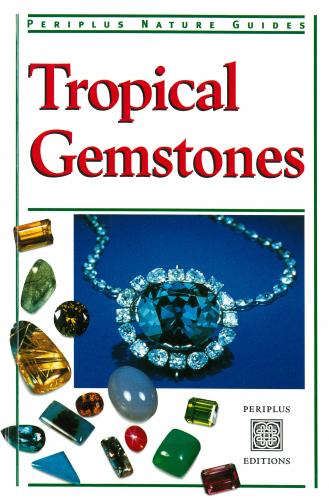An Indian maharajah wears enormous diamonds as part of his ceremonial finery. De Beers photo
Published by Periplus Editions (HK) Ltd.
ALL RIGHTS RESERVED
Printed in the Republic of Singapore
ISBN 962-593-184-8
ISBN 978-1-4629-1664-1 (ebook)
Publisher: Eric M. Oey
Design: Peter lvey
Editor: Julia Henderson
Production: TC Su
Distributors Indonesia PT Java Books, Kawasan Industri Pulogadung Jl Rawa Gelam IV No. 9 Jakarta 13930 Tel: (62) 21 4682-1088; Fax: (62) 21 461-0206 [email protected] www.periplus.co.id
Singapore and Malaysia Berkeley Books Pte Ltd 61 Tai Seng Avenue, #02-12 Singapore 534167 Tel: (65) 6280 1330 Fax: (65) 6280 6290 [email protected] www.periplus.com
Page 2: An Indian maharajah wears enormous diamonds as part of his ceremonial finery. De Beers photo
Pages 4-5: Magnificent rubies and sapphires from Sri Lanka Photo© Fred Ward 1997
Contents
The Nga Mauk Ruby
Sapphire
Enhancing Ruby and Sapphire
Star Ruby and Sapphire
Padparadscha
Spinel
Diamonds
Diamonds of India
The Hope Diamond
Topaz
Peridot
Garnet
Chrysoberyl Cat's Eye
Tourmaline
Emerald
The Emerald in History
Moonstone
Zircon
Opal
Jade
Jade in History
Jade and Buddhism
Pearls
The Pearling Industry
South Sea Pearls
Quartz
Unusual Gems
Indian Jewelry
Chinese Jewelry
Buying Gemstones
Introduction
Asia is blessed with more gemological riches than any other region on Earth. The ancient diamond mines of India provided many of the most celebrated gemstones of all time. The earth and streams of Thailand, Vietnam and Cambodia yield rubies and sapphires, while the warm, clear seas of Indonesia and the Philippines nurture exquisite South Sea pearls. Myanmar and Sri Lanka hold the most dazzling treasure troves of all, producing gemstones of legendary beauty and amazing variety.
Most of the gem mining activity in Myanmar centers around the town of Mogok in the northern part of the country, which is nicknamed "Ruby Land." A mountain road from Mandalay, twisting through ancient teak forests infested with highwaymen, leads to this elusive land of million-dollar gems. In addition to ruby, Mogok and its environs possess large deposits of sapphire, diamond, spinel, peridot, apatite, scapolite, moonstone, zircon, garnet, tourmaline, iolite and amethyst. Upper Myanmar is the world's only major source of jadeite, the most beautiful and desired of the jade minerals, while gigantic South Sea pearls are cultivated in the tropical seas off Myanmar's southern coast. Top gem buyers from around the world gather in Yangon for the Gem, Jade and Pearl Emporium, an annual auction held by the government.
The tropical island of Sri Lanka (formerly Ceylon) is commonly known as the "island of gems" because of the spectacular range of jewels found in its gravelly soil. It is most famous for its lovely sapphires, but it also produces ruby, diamond, garnet, alexandrite, spinel, zircon, peridot, topaz, tourmaline, moonstone and a highly-prized chrysoberyl cat's eye. Gems are found throughout central and southern Sri Lanka, but large-scale mining is concentrated in the Ratnapura and Elahera areas. Sri Lankan gems are found in the crown jewels of Europe and in artifacts from China's Ming Dynasty tombs. Historians trace Sri Lanka's international gem trade back to 500 B.C., when Buddhists from northern India conquered the island and began setting its gems into jewelry for export.
Gemstones are deeply embedded in Asian cultures. In China, the cult of jade worship began in the Neolithic era, when objects made of the precious material were used in religious ceremonies, agriculture and war. Stone and Bronze Age gem mining tools have been uncovered in Mogok. Even the most ancient Sanskrit manuscripts are rich with tales of fantastic jewels, both mythical and real. Hindu literature tells of a jewel called Syamantaka, that hung around the neck of the Sun-god and gave him brilliance. When the Sun god presented the divine gem to a mortal, havoc ensued, as other mortals envied the owner. Syamantaka was a powerful gem which brought good to good and evil to evil, and caused the death of any impure person who dared to wear it.
The Kalpa Tree, a symbolic offering to the gods; is described by Hindu poets as having a trunk of diamond and roots of sapphire. Its topaz branches dripped with pearls and sprouted leaves of zircon. This magical tree bore ruby and emerald fruit.
One of the oldest known talismanic jewels is the Naoratna, or the "nine-gem" jewel. Old Hindu treatises list the nine sacred gems which make up the naoratna as ruby diamond, pearl, coral, zircon, sapphire, topaz, chrysoberyl cat's eye and emerald. In modern times, the naoratna gems differ slightly—for instance, amethyst and garnet are sometimes substituted for zircon and cat's eye—but the spirit behind the jewel remains unchanged. Each of the gems are believed to be aligned with different planetary forces, and together they summon all the favorable influences of the celestial bodies. The purer the gems used in the naoratna, the greater the benefit it brings to its wearer. Poor or defective stones, on the other hand, can cause grave misfortune.
Enlightenment itself is described as a gem in the Buddhist faith—the rarest, most precious and beautiful of objects symbolizing the purest of human states. This belief is exemplified by Yangon's Shwedagon Pagoda, the most revered Buddhist shrine in Myanmar. A Myanmaran legend describes a shower of precious stones raining down on the site when the pagoda was first built, sometime around the 11th century. The shower of gems may be legend,
